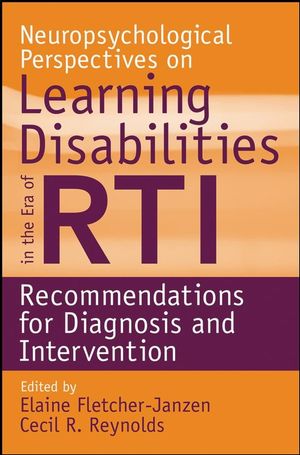Neuropsychological Perspectives on Learning Disabilities in the Era of RTI: Recommendations for Diagnosis and InterventionISBN: 978-0-470-22527-1
Paperback
352 pages
February 2008
 This is a Print-on-Demand title. It will be printed specifically to fill your order. Please allow an additional 10-15 days delivery time. The book is not returnable.
|
||||||
Chapter 2. RTI, Neuroscience, and Sense: Chaos in the Diagnosis and Treatment of Learning Disabilities (By Cecil R. Reynolds).
Chapter 3. Neuroscience and RTI: A Complementary Role (By H. Lee Swanson).
Chapter 4. The Education Empire Strikes Back: Will RTI Displace Neuropsychology and Neuroscience from the Realm of Learning Disabilities (By Merrill Hiscock and Marcel Kinsbourne)?
Chapter 5. Nature-Nurture Perspectives in Diagnosing and Treating Learning Disabilities: Response to Questions Begging Answers That See the Forest and the Trees (By Virginia W. Berninger and James A. Holdnack).
Chapter 6. Compatibility of Neuropsychology and RTI in the Diagnosis and Assessment of Learning Disabilities (By Cynthia A. Riccio).
Chapter 7. Assessment versus Testing and its Importance in Learning Disability Diagnosis (By Julie A. Suhr).
Chapter 8. Comprehensive Assessment Must Play a Role in RTI (By Steven J. Hughes).
Chapter 9. The Need to Integrate Cognitive Neuroscience and Neuropsychology into a RTI Model (By Daniel C. Miller).
Chapter 10. Neuropsychological Assessment and RTI in the Assessment of Learning Disabilities: Are They Mutually Exclusive (By David Breiger and Lawrence V. Majovski)?
Chapter 11. Learning Disabilities: Complementary Views from Neuroscience, Neuropsychology, and Public Health (By Ronald T. Brown, Brian P. Daly, and Gerry A. Stefanatos).
Chapter 12. Integrating Science and Practice in Education (By Richard Boada, Margaret Riddle, and Bruce F. Pennington).
Chapter 13. Perspectives on RTI from Neuropsychology (By Scott L. Decker, Jessica A. Carboni, and Kimberly B. Oliver).
Chapter 14. Neuropsychological Aspects of Learning Disabilities Determination: Scientific and Cultural Considerations (By Sangeeta Dey).
Chapter 15. Identifying a Learning Disability: Not Just Product, but Process (By Colin D. Elliott).
Chapter 16. Integrating RTI with Cognitive Neuroscience in the Assessment of Learning Disabilities (By Steven G. Feifer).
Chapter 17. Neuropsychology and the Implications for Policy, Diagnosis, and RTI By Lisa A. Pass and Raymond S. Dean).
Chapter 18. Neuroscience, Neuropsychology, and Education: Learning to Work and Play Well with Each Other (By Michael D. Franzen).
Chapter 19. Diagnosing Learning Disabilities in Non-Majority Groups: The Challenges and Problems of Applying Non-Neuropsychological Approaches (By Javier Gontier and Antonio E. Puente).
Chapter 20. The Role of Neuroscience and Neuropsychology in the Diagnosis of Learning Differences and the RTI Paradigm (By Sally L. Kemp and Marit Korkman).
Chapter 21. Q & A about the Role of Neuroscience and Neuropsychology in the Assessment and Treatment of Learning Disorders (By Rosemarie Scolaro Moser).
Chapter 22. RTI and Neuropsychology: Antithesis or Synthesis (By Andrew L. Schmitt, Ronald B. Livingston, and Owen Carr).
Chapter 23. Utilizing RTI as an Opportunity to Identify and Plan More Effective Educational Interventions for Children with Learning Disabilities (By Amy Nilson Connery).
Chapter 24. Neuropsychology, Neuroscience, and Learning Disabilities: Brain Behavior Relationships (By Arthur MacNeill Horton, Jr.).
Chapter 25. Knowing Is Not Enough -- We Must Apply. Willing Is Not Enough – We Must Do (By Elaine Fletcher-Janzen).



